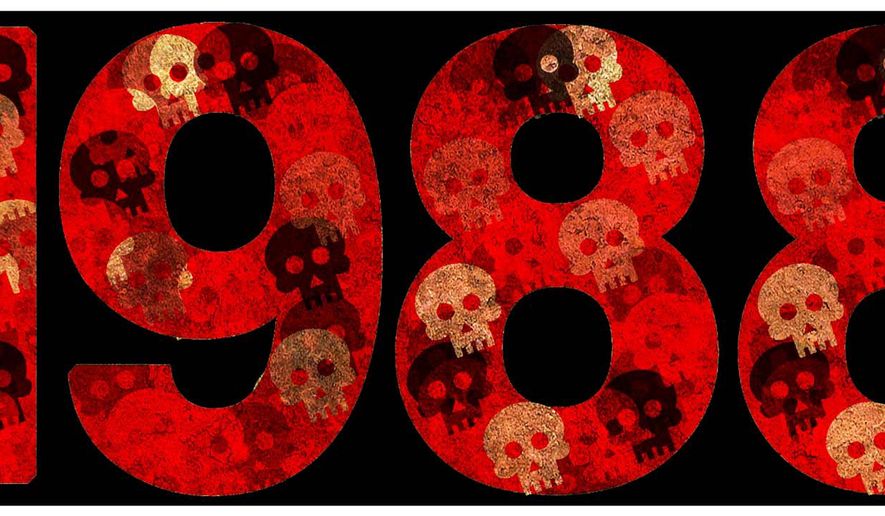OPINION:
In August, damning evidence was made public about those responsible for the biggest massacre of political prisoners since World War II. The massacre took place in Iran, now portrayed as being run by moderates.
The brutality and radical ideology that guided the mass executions in 1988 are alive and well. Just ask the people of Iran itself, as well as those of Syria, Iraq and elsewhere. How is it that this historic leak has, with few exceptions, been met with indifference? Not only does it present an opportunity for justice for the 30,000 victims and their families, but it could and should also shape some of the most important debates in foreign policy today.
Grand Ayatollah Hossein-Ali Montazeri wasn’t someone you would call a liberal, or even a moderate. He detested democracy, favoring instead the ideology of Velayat-e Faqih, which espoused the notion of giving the clergy unlimited power to decide the fate and daily life of the Iranian people. Once slated to succeed Ayatollah Ruhollah Khomeini, Montazeri was an ideologue of the ridged Shia dogma that would lead to the massacre of 30,000 innocent men, women (even if pregnant) and children. Yet, as the newly released audio recordings clearly indicate, even Montazeri felt compelled to speak out against the bloodbath.
The carnage targeted dissidents the regime had already sentenced, activists of the People’s Mojahedin Organization of Iran (PMOI or MEK), who were in prison and could not be pegged with more fabricated charges by the government. In Montazeri’s recorded words, “This sort of mass executions without trials, particularly as it relates to prisoners and captives — they are your captives, after all — definitely over time will favor them, and the world will condemn us and they will be even more encouraged in their resistance. Killing is the wrong way to resist against a thought, an idea . They have one thought, one idea. Responding to a process, a logic, even a faulty logic, with killing will solve nothing. It will make it worse . We will not be in power forever. In the future, history will judge us .”
One would expect that this sort of objection from a senior cleric and zealot of the extremist, reactionary ideals of the establishment would bring about change, and that those who had committed these unspeakable crimes would not be in favor forever. It turns out that there was change: Montazeri was sacked and those who murdered innocent prisoners on an unimaginable scale were promoted.
The members of the “death commission” are now serving in senior positions within the so-called moderate government of Hassan Rouhani. Mostafa Pourmohammadi is the justice minister in Mr. Rouhani’s Cabinet. Hossein-Ali Nayyeri is the current head of the Supreme Disciplinary Court for Judges. Ebrahim Raeesi was the clerical regime’s prosecutor general until several months ago and has recently been appointed by Supreme Leader Ali Khamenei as the head of the Astan Quds-e Razavi foundation, which is a multibillion-dollar religious, political and economic conglomerate and one of the most important political and economic powerhouses in the clerical regime.
These mass murderers’ current positions aren’t just an insult to those Iranians who paid the ultimate price in 1988; they are also a death sentence for innocent Iranians today, and a warning of the intentions of the Rouhani government abroad. At home, under Mr. Rouhani’s “moderate” leadership, Iran is the world’s No. 1 state executioner as no less than 2,600 people, including many dissidents, have been executed. Religious and ethnic minorities number disproportionately among the several thousand perceived opponents who have been hung from cranes over the past few years. Abroad, the regime has become ever more brazen due to Western inaction and ransom payments in the framework of nuclear negotiations. In Syria, Iraq and beyond, Iranian meddling and direct action supports despots such as Bashar Assad and suffering and death on a massive scale.
Just a few days ago, a five-year-old Syrian child named Omran Daqneesh became the face of the latest round of suffering and death in Syria, in a campaign made possible by the Iranian government. Unlike the 1988 victims of terror, today’s victims are likely to be more than a number, to have a human face like Omran’s — covered in dirt and blood from an airstrike — their shock and despair captured on camera. Such scenes should act as a wake-up call; no longer can we sit idly by as innocents are slaughtered. It is time for us to raise our voices in the name of the victims of Iranian terror who cannot, either because they are being suppressed or already dead.
Isn’t it time to call for justice for the victims of the 1988 massacre and hold the perpetrators accountable?
• Hugh Shelton, a retired U.S. Army general, is a former chairman of the U.S. Joint Chiefs of Staff.




Please read our comment policy before commenting.